 |
|
|
 |
 oung collectors want an environment that is comfortable and adaptable to their lifestyles. Whether hosting a large dinner party, visiting with a small group of friends, or relaxing with family, people need to feel “at home” in their living space. A young Manhattan couple has accomplished this by creating a home that combines the best in antiques and modern living. oung collectors want an environment that is comfortable and adaptable to their lifestyles. Whether hosting a large dinner party, visiting with a small group of friends, or relaxing with family, people need to feel “at home” in their living space. A young Manhattan couple has accomplished this by creating a home that combines the best in antiques and modern living.
 |
 |
 |
Entryway and dining room of a Manhattan apartment. Among the antiques are federal Boston chairs from Israel Sack, Inc., that are identical to chairs in the Karolik collection at the Museum of Fine Arts, Boston; a pair of knife boxes from Philip Bradley; Severin Roesen’s Nature’s Bounty from Holland & Co. above the sideboard; and Levi aWells Prentice’s Still Life of Strawberries from Berry-Hill Galleries. Featured on the sideboard is a circa 1860 canary yellow Sandwich glass compote, a gift of special significance for the couple.
|
Philip and Jamila are the parents of three small children who range in age from 1 to 6. As a child, Philip was discouraged from approaching his grandmother’s antiques, growing up thinking that antiques were taboo. It wasn’t until he began a collection of early American glass as a young adult that he realized how exciting the world of antiques could be. After meeting his future wife, he soon drew her into the fold, and the two embarked on buying the best examples of brilliant colored Sandwich and Pittsburgh glass they could acquire. After having children, the couple continued to collect, creatively displaying most of their glass collection in a custom-made breakfront, designed with period inspiration to complement their antiques.
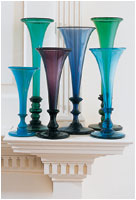 |
 |
 |
A group of colored nineteenth-centurytrumpet vases decorates the custom-builtfederal-style mantel.
|
Because of Philip’s childhood experience and his and Jamila’s feeling that it is important to provide enriching experiences for their children, the couple casually blend Chippendale chairs with modern sofas.
 |
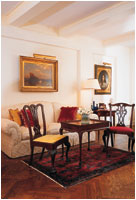 |
 |
Entryway and dining room of a Manhattan apartment. Among the antiques are federal Boston chairs from Israel Sack, Inc., that are identical to chairs in the Karolik collection at the Museum of Fine Arts, Boston; a pair of knife boxes from Philip Bradley; Severin Roesen’s Nature’s Bounty from Holland & Co. above the sideboard; and Levi Wells Prentice’s Still Life of Strawberries from Berry-Hill Galleries. Featured on the sideboard is a circa 1860 canary yellow Sandwich glass compote, a gift of special significance for the couple.
|
Allowed to play the circa 1900 Hamburg Steinway & Sons “C” piano, ride their tricycles through the apartment, and store their clothing in a federal period chest, the children are learning to respect and appreciate antiques, a sense that will no doubt develop with age. As Jamila says, “sometimes they give me a knowing look, and we smile at each other as they replace an antique with some of their artwork, which of course we encourage.”
The “love of the hunt” best describes the impetus behind this couple’s collection, which ranges from eighteenth- to early nineteenth-century American furniture, paintings, and blown and pressed glass. Adhering to Albert Sack’s theory of “Good, Better, Best,” the couple is determined to indeed collect “only the best.” In this pursuit they rely on advice from dealers and other experts as well as their own research, gained from reading trade papers and magazines, handling the objects, and attending antiques shows.
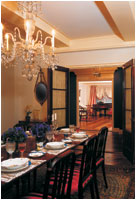 |
 |
 |
The couple decorate their own apartment, carefully selecting antiques that are best suited to the space. For the architectural details and color schemes, the couple worked with architect John Tackett, of Design Studios, now based in Memphis, Tennessee. One of their favorite pieces is the Adams glass chandelier from the late 1700s they
purchased from Philip Colleck.
|
We have bought from some wonderful dealers,” says Jamila, “either at shows or at their galleries. When we do buy at auctions we prefer to use a dealer as our agent.” “An important aspect of our collecting,” Philip notes, “is the personalities involved, the friendships we form.
We have met some wonderful people, both collectors and dealers, through this experience.”
“We have discovered that the best way to find what we are looking for is to tell dealers what we want,” says Jamila. “When presented with an object, however, it may take some time for us to make a decision.” This was the case with an Adams glass chandelier, which they finally purchased after many long discussions.
 |
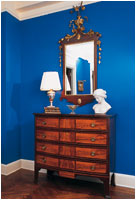 |
 |
Some of the couple’s favorite antiques are federal pieces with contrasting panels. They are particularly fond of furniture from Portsmouth, New Hampshire, such as this drop-panel chest with French feet. Hanging over the chest is a mirror from the Adolph Meyer collection.
|
“Sometimes,” she says, “if we wait too long before making a decision we lose the piece to another collector. My husband thought that was what had happened to him after he took months to decide about purchasing a canary yellow Sandwich glass compote. When he finally made the decision to buy it as a birthday present for himself, he was distressed to discover that it had been sold. Fortunately for him, I had bought it as a gift—a good lesson for us to have learned.” As with the canary yellow compote, each piece the couple has found has a story, which adds to their collecting experience. “The underlying theme to our collecting,” says Jamila, “is that we buy with our hearts.”
Over the years, they have realized that their tastes sometimes differ. Philip prefers eighteenth- and early-nineteenth-century antiques while Jamila is more swayed by the classical and empire styles. In addition to their mutual admiration for Sandwich and Pittsburgh glass, their tastes overlap with federal period furniture, with its contrasts of light and dark wood. Some of their favorite furniture is from Portsmouth, New Hampshire, recognized for its “flame-birch” and mahogany contrasts. They also agree on the style of painting they prefer, simultaneously being swept off their feet when they saw a Severin Roesen still life of fruit hanging in a gallery—it now graces their dining room.
|
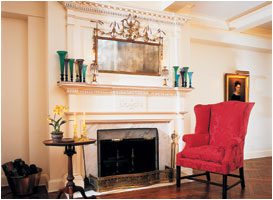 |
 |
 |
The couple’s first major American furniture purchase was the Philadelphia tilt-top tea table, circa 1770, they bought from Israel Sack, Inc. The
couple enjoy visiting the Sacks because, as Jamila says, “it’s as if we are in a museum.” Also featured is a federal over-mantel mirror from David Dunton above matching andirons, tools, and jamb hooks from Carswell Rush Berlin; brass fender from Eve Stone; a red Chippendale easy chair from Thomas Schwenke; and a portrait attributed to New Hampshire folk painter Ethan Allen Greenwood (1779–1856), purchased at a show in Hartford, Connecticut.
|
One of their goals is to continue to improve their collection by trading up, finding finer examples of pieces they currently have in their collection. Calling their home a “work in progress,” the couple also has a “wish list.” Among the objects for which they are looking, is an Oriental nineteenth-century Kirman rug and a Boston or Salem Chippendale bonnet-top block-front secretary bookcase for the living room, and a Martin Johnson Heade sunset marsh scene. Like true collectors, they will search until they find just the right piece rather than purchase an item just to fill a space. This will mean visiting more dealers’ shops, shows, and anywhere antiques may be found. The love of the hunt continues.
|
|
|